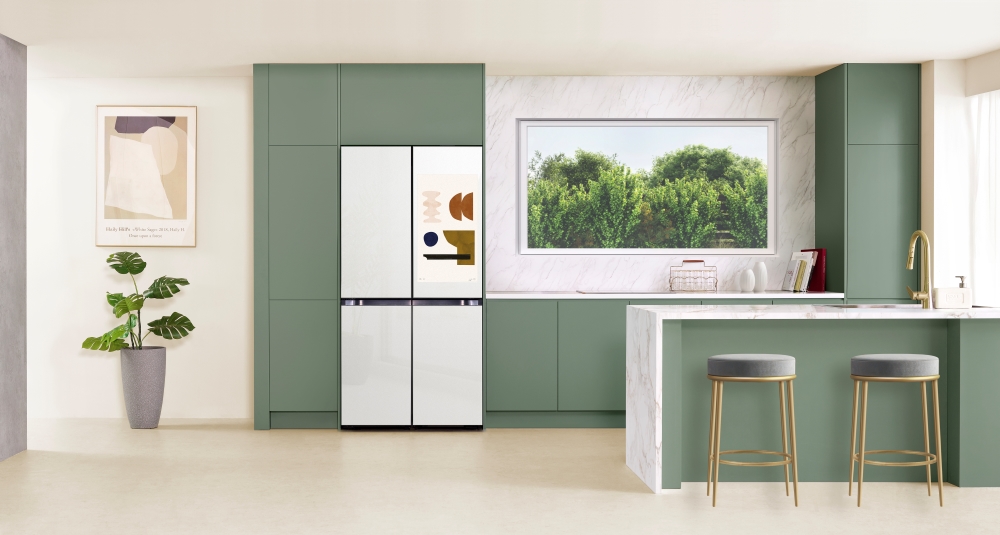Revolutionizing Refrigeration with AI Hybrid Cooling and Peltier Effect
The evolution of refrigeration technology has been a cornerstone of innovation in the home appliance industry. From traditional compressor systems to AI-driven hybrid cooling, Samsung has once again revolutionized the market with the integration of Peltier effect technology. This innovation delivers groundbreaking advancements in energy efficiency, temperature control, and environmental sustainability, enhancing the overall consumer experience.

The Peltier Effect: A Thermoelectric Phenomenon
Discovered in 1834 by French physicist Jean Charles Athanase Peltier, the Peltier effect describes a thermoelectric phenomenon where the junction of two different conductors or semiconductors absorbs heat on one side (cooling) and releases it on the other (heating) when an electric current flows through it.
Cooling Process
• Heat Absorption at the Cold Side: When current flows through a Peltier module, the cold side absorbs heat, cooling the air inside the refrigerator.
• Heat Dissipation at the Hot Side: The hot side expels the absorbed heat into the external environment through heat sinks or fans.
Temperature Control
• Precision Regulation: Adjusting the electric current allows for precise temperature control, making Peltier modules ideal for temperature-sensitive storage applications.
Environmental Benefits
• No Refrigerants Needed: Peltier cooling operates solely on electronic transfer, eliminating the need for traditional refrigerants like Freon, making it environmentally friendly and pollution-free.
Samsung’s Innovation in AI Hybrid Cooling
Samsung’s AI Hybrid Cooling technology masterfully combines traditional compressor systems with Peltier modules, optimized through AI algorithms to balance performance and energy efficiency.
1. Synergy Between Compressor and Peltier Modules
• The AI inverter compressor operates as the primary cooling system during normal conditions, ensuring low energy consumption.
• The Peltier module activates during peak cooling demands, such as when the door opens, delivering rapid and precise cooling to restore the internal environment.
2. AI-Driven Optimization
• Leveraging AI algorithms, the system dynamically adjusts operations based on user habits, such as door-opening frequency or restocking times, maintaining an ideal temperature consistently.
3. Improved Storage Efficiency and Capacity
• With no moving parts, the Peltier module frees up more internal space, increasing refrigerator capacity by 25 liters while also reducing operational noise.
Benefits for Consumers
Precise Temperature Control and Extended Freshness
The Peltier module’s precise temperature regulation significantly extends food freshness. Tests have shown meat stays fresh 1.4 times longer and fish 1.2 times longer compared to traditional refrigerators, catering to consumers who value quality food preservation.
Energy Savings and Cost Reduction
By delegating high-load cooling tasks to the Peltier module, the compressor experiences less strain, reducing overall energy consumption and lowering maintenance costs.
Sustainability and Environmental Impact
Samsung’s AI Hybrid Cooling technology addresses global energy efficiency and sustainability goals by reducing reliance on traditional refrigerants and optimizing energy use. This innovation supports environmentally conscious living while minimizing the product’s carbon footprint.
Looking Ahead: The Future of AI and Thermoelectric Cooling
The launch of Samsung’s AI Hybrid Cooling technology not only redefines the standards of refrigeration but also sets a template for smart upgrades in other home appliances. Combining the Peltier effect with AI technology is a significant step towards intelligent and sustainable refrigeration.
As consumer demand for energy efficiency, precise temperature control, and sustainability grows, AI Hybrid Cooling is poised to become the industry standard. Samsung has undoubtedly set a commendable benchmark through its technological innovation, leading the way in shaping smarter, more sustainable homes.
在家电领域,制冷技术的进步一直是推动行业创新的重要引擎。从传统压缩机制冷到如今的AI混合制冷,三星通过整合珀尔帖效应技术,为冰箱行业带来了颠覆性的变化。这项技术不仅在能源效率、温度控制和环保性能上取得了突破,还为消费者提供了更优质的使用体验。

珀尔帖效应:热电现象的核心原理
珀尔帖效应是1834年由法国物理学家Jean Charles Athanase Peltier发现的一种热电效应。当直流电流通过两种不同导体或半导体的接触点时,一侧会吸热(冷却),另一侧则放热(加热)。
制冷过程
• 冷端吸热:当电流通过珀尔帖模块的半导体材料时,冷端吸收热量,将冷空气释放到冰箱内部。
• 热端散热:热端则通过散热片或风扇等装置将热量排到外部环境。
温度控制
• 精确调节:通过调整电流的大小,可以实现冷端温度的精确控制。这种能力使珀尔帖技术特别适合用于对温度敏感的食品或药品存储场景。
环保特性
• 无制冷剂:珀尔帖制冷完全基于电子转移,无需使用传统的氟利昂等制冷剂,既环保又无污染。
三星AI混合制冷技术的创新
三星的AI混合制冷技术融合了传统压缩机和珀尔帖模块的优势,通过AI算法的优化,在性能与能效之间达到了完美平衡。
1. 压缩机与珀尔帖的协同作用
• 在日常使用中,AI变频压缩机作为主要冷却设备,保持低能耗运行。
• 当检测到高峰冷却需求时,例如门打开后温度上升,珀尔帖模块迅速启动,通过精确调节温度,快速恢复内部环境。
2. AI驱动的智能优化
• AI算法会根据用户的使用习惯(如开门频率、放入新食材的时间)动态调整压缩机和珀尔帖模块的协作方式,确保始终保持最佳温度。
3. 提升储存效率与容量
• 与传统设计相比,珀尔帖模块的无机械结构特性释放了更多内部空间,使冰箱容量增加了25升,同时降低了噪音。
技术优势与消费者利益
精确控温延长保鲜期
珀尔帖模块的高精度温控性能在食品保鲜方面表现卓越。例如,在实际测试中,肉类可以多保鲜1.4倍,鱼类可以多保鲜1.2倍。这对于注重饮食品质的消费者而言,是一项不可忽视的优势。
降低能耗与运营成本
由于珀尔帖模块在高峰负载时承担了大部分冷却任务,压缩机的工作强度显著降低。这种分工协作减少了总体能耗,也降低了设备的维护成本。
环保与可持续发展
通过减少传统制冷剂的使用和优化能源效率,三星的AI混合制冷技术积极响应了全球节能减排的号召。它不仅降低了产品的碳足迹,还对消费者倡导可持续生活方式起到了推动作用。
##展望未来:AI与热电技术的结合
三星AI混合制冷技术的推出不仅重新定义了冰箱行业的技术标准,也为其他家电产品的智能化升级提供了模板。珀尔帖效应与AI技术的结合,是冰箱行业迈向智能化和环保化的重要一步。
可以预见,随着用户对能源效率、精准温控和可持续性的需求不断增加,AI混合制冷将成为未来冰箱行业的主流趋势。而三星无疑通过其技术创新,树立了一个令人敬佩的行业标杆。